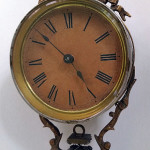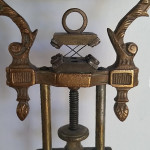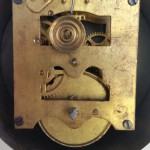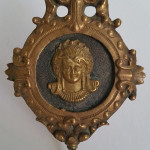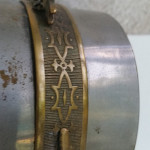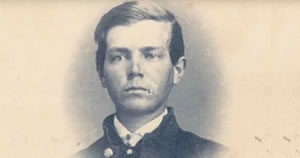This clock is a type of Swinging Arm – or “Swinger” – clock that was sold during the mid- to late 1880s. This was the same period during which the Bobbing Doll (Ansonia Jumper Clock), model was manufactured. This particular clock is called a “Tin Can Swinger” because the upper portion containing the movement and paper dial resembles a tin can turned on its side.
The swinging lower portion of this clock was originally nickel-plated brass mixed with polished brass. As one can see, much of the nickel has oxidized or worn off. The white metal warrior statue, although the proper height, was probably converted for use as the swinging arm; no known Ansonia catalog from this period depicts the warrior statue being used as a component of a Swinging Arm clock. Because of the frail nature of white metal, it is common to see the arms of statues like this one broken off or to see that the original statues are missing. All of this particular statue’s original finish has worn off or oxidized after years of dusting and cleaning.
|
Detail photo of the head & dial of Swinger clock. |
Detail photo of X spring suspension and surrounding frame. |
|
Detail of the inside of the Tin Can housing and the miniature clock movement. Note here we see the true pendulum bob which imparts the to and fro motion of the Swinging Clock as the true bob swings inside the housing hidden from our view. |
Detail of faux pendulum bob. Note the Egyptian influence common in this era.of the 1886 Phidelphia Exposition and just after the U.S.A. Centennial. |
|
Ornate cast brass frame of the “Tin Can ” movement housing. The Nickel plating and oxidation clearly visible. |
|



